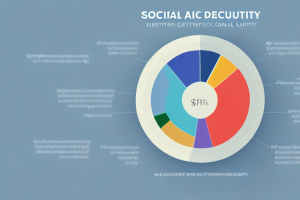Social Security is a vital source of income for many individuals, especially during retirement. It provides financial stability and peace of mind for those who have worked hard throughout their lives. However, navigating the complexities of the Social Security system can be daunting. In this comprehensive guide, we will delve deep into the various aspects of Social Security to help you understand, plan, and maximize your benefits.
Understanding the Basics of Social Security
First, let’s start with the fundamentals. The Social Security program is managed by the Social Security Administration (SSA) and provides retirement, disability, and survivor benefits to eligible individuals. The program operates on a pay-as-you-go system, where current workers’ contributions fund the benefits of current retirees.
Eligibility for Social Security benefits is primarily based on your earnings history and the number of Social Security credits you have earned. You earn credits by working and paying Social Security taxes. The more you earn and pay into the system, the more credits you accumulate.
In addition to retirement, disability, and survivor benefits, the Social Security program also provides supplemental security income (SSI) to individuals with limited income and resources. SSI is a needs-based program that helps eligible individuals meet their basic needs for food, clothing, and shelter. Unlike other Social Security benefits, SSI is not based on your work history or Social Security credits, but rather on your financial need.
Eligibility Criteria for Receiving Social Security Benefits
To be eligible for Social Security benefits, you must have accumulated a sufficient number of credits and have reached the age of eligibility. The age at which you can start receiving retirement benefits ranges from 62 to 67, depending on your birth year. However, it’s important to note that claiming benefits earlier can result in a reduction of your monthly benefit amount. Additionally, certain circumstances, such as disability or qualifying as a survivor, may allow for earlier eligibility.
Furthermore, if you plan to continue working while receiving Social Security benefits, there are income limits to consider. If you exceed these limits, your benefits may be reduced, and understanding how these limits apply to your situation is crucial in maximizing your benefits.
It’s also worth mentioning that if you choose to delay receiving Social Security benefits beyond your full retirement age, your monthly benefit amount may increase. For each year you delay, up until the age of 70, your benefit amount can increase by a certain percentage. This can be a strategic decision for individuals who are able to continue working or have other sources of income during this period.
Maximizing Your Social Security Benefits: Tips and Strategies
Now that we’ve covered the basics and eligibility criteria, let’s explore strategies for maximizing your Social Security benefits. One important aspect to consider is the timing of your benefit claim. While you can claim benefits as early as age 62, delaying your claim can result in an increased monthly benefit amount. For each year you delay claiming benefits beyond full retirement age, your monthly benefit increases by a certain percentage, up until age 70.
Another strategy to consider is coordinating benefits with your spouse. This can involve carefully planning each spouse’s claiming strategy to optimize the overall benefit amount for your household. Additionally, understanding the impact of divorce on Social Security benefits is essential for those who have been through or are considering a divorce.
One more strategy to maximize your Social Security benefits is to consider the impact of working while receiving benefits. If you choose to claim benefits before reaching full retirement age and continue to work, your benefits may be subject to the earnings test. This means that if you earn above a certain limit, a portion of your benefits may be withheld. However, once you reach full retirement age, there is no longer an earnings test, and you can work and earn as much as you want without any reduction in your benefits.
Exploring Different Types of Social Security Benefits
Social Security provides various types of benefits, including retirement, disability, survivor, and spousal benefits. Retirement benefits are the most common and are available to individuals who have accumulated enough credits and have reached the appropriate age of eligibility.
Disability benefits, on the other hand, are intended for those who are unable to work due to a disability and have met the necessary eligibility requirements. Survivor benefits are available to qualified family members of deceased workers, providing financial support during difficult times.
Lastly, spousal benefits allow individuals to claim benefits based on their spouse’s earnings history. Understanding the intricacies of these benefit types and how they may apply to your situation is crucial when seeking to maximize your Social Security benefits.
Retirement benefits are calculated based on an individual’s average earnings over their working years. The amount of benefits received will depend on factors such as the age at which benefits are claimed and the individual’s earnings history. It’s important to carefully consider when to start receiving retirement benefits, as claiming benefits earlier than the full retirement age may result in a reduction in monthly payments.
Disability benefits require individuals to meet strict criteria to qualify. The Social Security Administration evaluates the severity of the disability and its impact on the individual’s ability to work. It’s important to note that disability benefits are not available for short-term or partial disabilities, and there is a waiting period before benefits can be received.
Factors that Determine Your Social Security Benefit Amount
The calculation of your Social Security benefit amount considers several factors, including your earnings history, the age at which you claim benefits, and the number of credits you have earned. The Social Security Administration uses a formula that takes your highest 35 years of earnings into account, adjusting for inflation, to calculate your average indexed monthly earnings (AIME).
From your AIME, the Social Security Administration applies a bend point formula to determine your primary insurance amount (PIA), which represents your monthly benefit at full retirement age. By understanding these calculations, you can estimate your future benefit amount and plan accordingly.
How to Calculate Your Estimated Social Security Benefit
To estimate your Social Security benefit amount, you can utilize the Social Security Administration’s online tools or consult with your financial advisor. These resources allow you to input your earnings history and projected retirement age to generate an estimate of your monthly benefit. Remember to consider factors such as inflation and changes to the Social Security program in your calculations.
The Importance of Planning Ahead for Social Security
Planning ahead for Social Security is crucial to maximize your benefits and ensure a comfortable retirement. It’s important to understand the impact of your lifestyle choices, such as when you choose to retire, on your benefits. Whether you decide to continue working, claim benefits early, or delay your claim, planning ahead allows you to make informed decisions about your future financial security.
Navigating the Social Security Application Process
Applying for Social Security benefits can be a complex process, but with proper preparation, it becomes more manageable. The Social Security Administration provides online resources to help you navigate the application process. Be sure to gather all the necessary documentation and understand the required forms, as accuracy and completeness are crucial to avoid delays or errors in processing your application.
Common Mistakes to Avoid When Applying for Social Security Benefits
While applying for Social Security benefits, it’s essential to avoid common mistakes that could affect your benefit amount or eligibility. Some common pitfalls include failing to consider the impact of early claiming, not coordinating benefits with your spouse, and overlooking the potential impact of continued work. By familiarizing yourself with these mistakes, you can make informed decisions and optimize your benefits.
Understanding the Impact of Early or Delayed Retirement on Social Security Benefits
Deciding when to retire can significantly impact your Social Security benefits. Claiming benefits before your full retirement age can result in a reduction of your monthly benefit amount. Conversely, delaying your claim can result in an increase in your benefit amount. By understanding the implications of early or delayed retirement, you can choose the option that aligns with your financial goals and objectives.
How Work History Affects Your Social Security Benefits
Your work history plays a significant role in determining your Social Security benefits. The more you earn and pay into the system, the higher your benefit amount will be. However, it’s important to know that earning more now might not necessarily translate into a higher benefit amount in the future due to the Social Security’s progressive benefit structure.
Strategies for Increasing Your Lifetime Earnings and Maximizing Social Security Benefits
Maximizing your lifetime earnings can positively impact your Social Security benefits. This can be achieved through strategic career choices, such as pursuing higher-paying jobs or investing in education and skills development. Additionally, understanding the impact of part-time work or self-employment on your benefits is crucial in ensuring you can make the most of your lifetime earnings.
How Spousal Benefits Work in the Context of Social Security
Spousal benefits are an integral part of Social Security and can provide additional financial support for individuals who have lower lifetime earnings or choose not to claim their own benefits. Spouses can claim a benefit amount based on their partner’s earnings, even if they have never worked or earned sufficient credits on their own. Understanding the rules and options for spousal benefits is essential for married couples planning for retirement.
The Role of Divorce in Determining Social Security Benefits
Divorce can have implications on Social Security benefits, and it’s essential to understand how your marital status affects your eligibility and benefit amount. In general, if you were married for at least ten years and remain unmarried, you may be eligible to claim benefits based on your ex-spouse’s earnings history. Exploring the options and rules surrounding divorced-spouse benefits can help you make informed decisions about your retirement planning.
Exploring Survivor Benefits: What You Need to Know
Survivor benefits provide financial support to eligible family members in the event of a worker’s death. These benefits can be crucial for a surviving spouse or dependent children. Understanding who qualifies for survivor benefits, how the benefit amount is calculated, and the potential impact on your overall financial plan is crucial for long-term financial security.
Understanding the Tax Implications of Receiving Social Security Benefits
While Social Security benefits provide a vital income source during retirement, it’s important to be aware of the potential tax consequences. Depending on your total income, a portion of your Social Security benefits may be subject to federal income tax. Understanding these tax implications allows you to plan accordingly and avoid any surprises during tax season.
The Role of Medicare in Conjunction with Social Security Benefits
Medicare is another crucial component of retirement planning that works alongside Social Security benefits. Medicare provides healthcare coverage for individuals aged 65 and older and for certain younger individuals with disabilities. Understanding the relationship between Social Security and Medicare is essential to ensure comprehensive and well-rounded retirement planning.
In conclusion, obtaining 100% of your Social Security benefits involves careful planning, understanding the eligibility criteria, and making strategic decisions. By comprehensively addressing the various aspects of Social Security, from the basics to specific benefit types and planning strategies, this guide aims to equip you with the knowledge necessary to optimize your benefits and secure a financially stable retirement.



